After two weeks of the international break, Manchester City met Crystal Palace at Selhurst Park resuming their Premier League campaign. Just before the break, City dropped points at home after losing to Wolves extending Liverpool’s lead in the league to eight points. Considering the fine margins by which the previous season’s league campaign was fought with Liverpool, it was important for City to respond and catch up immediately to retain their title for a third time.
Following this game against Crystal Palace, City would have to play Atalanta in the Champions League just two days after. Thus City’s tactics were to find three points from this fixture without risking injuries, at the same time saving key players for the mid-week UCL clash. But as we shall see in this analysis, City were pushed to defend constantly from a threatening Palace side. Let’s examine how both teams worked their tactics out in this tactical analysis.
Lineups
City’s central defender crisis has forced Pep Guardiola to think outside the box. Aymeric Laporte’s injury required Nicolas Otamendi to step in for the previous games but he has had lapses in his game costing City goals on counter-attacks. John Stones is only just making it back from his injury. Fernandinho has slotted in as a centreback from the regular defensive midfielder role he had last season. Although Pep had mentioned in press conferences that the new signing from Atletico Madrid, Rodri, is capable of playing as a centreback, he hadn’t been tested yet.
In this game, City lined up in a 4-3-3 with the centre-back partnership of two defensive midfielders, Rodri and Fernandinho. İlkay Gündoğan played the pivot in front of them. Benjamin Mendy and Joao Cancelo were selected to operate as fullbacks who would attack the inner corridors. David Silva and Kevin De Bruyne were the two attacking midfielders and they orchestrated the attack along with Gabriel Jesus as the centre forward and Raheem Sterling and Bernardo Silva on the wings.
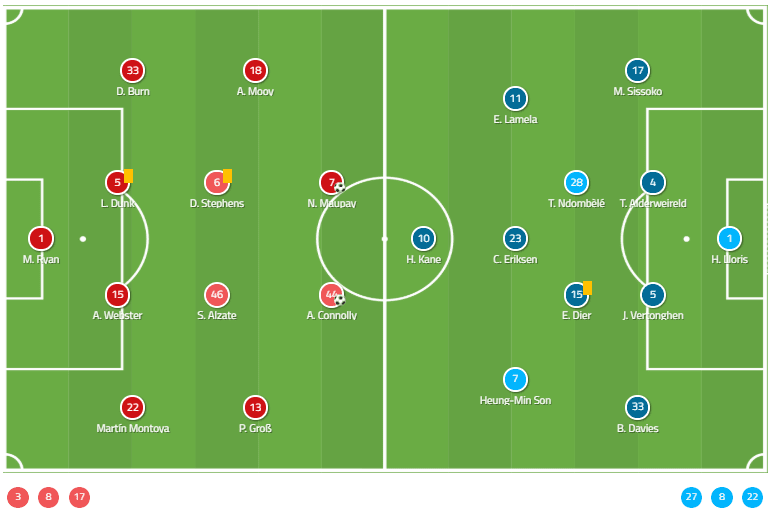
Crystal Palace lined up in a 4-5-1 with Joel Ward, James Tomkins, Gary Cahill and Patrick van Aanholt forming the back four. Luka Milivojević and Cheikhou Kouyaté operated in central midfield with James McArthur playing a free role to man-mark the City players between the lines. Jeffrey Schlupp would operate on the left wing. Although Wilfried Zaha was positioned on the right wing, he had the freedom to join the attack centrally. Jordan Ayew played as the lone striker.
City’s ‘makeshift’ defence
After falling short against Wolves, especially in their buildup, everyone was expecting a reaction from Guardiola’s side. He responded likewise playing a highly positional game with short passes to open up the opposition. Having midfielders as centrebacks meant City would look to have a lot of the ball while building up from the back. The intention was to use Fernandinho and Rodri for their passing and positional abilities rather than their defensive attributes. We also saw the two pushing very high up with the ball courageously, all the way into the final third. Out of City’s 714 passes in total, 625 (87%) were short passes.
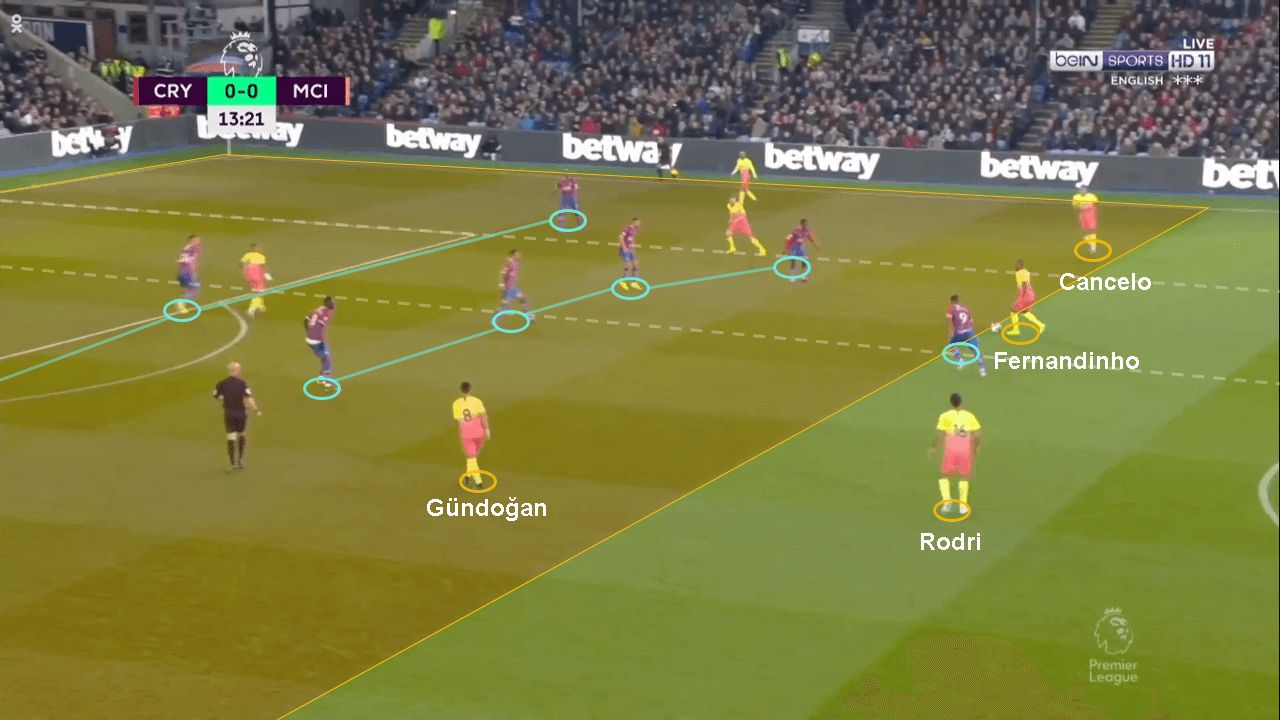
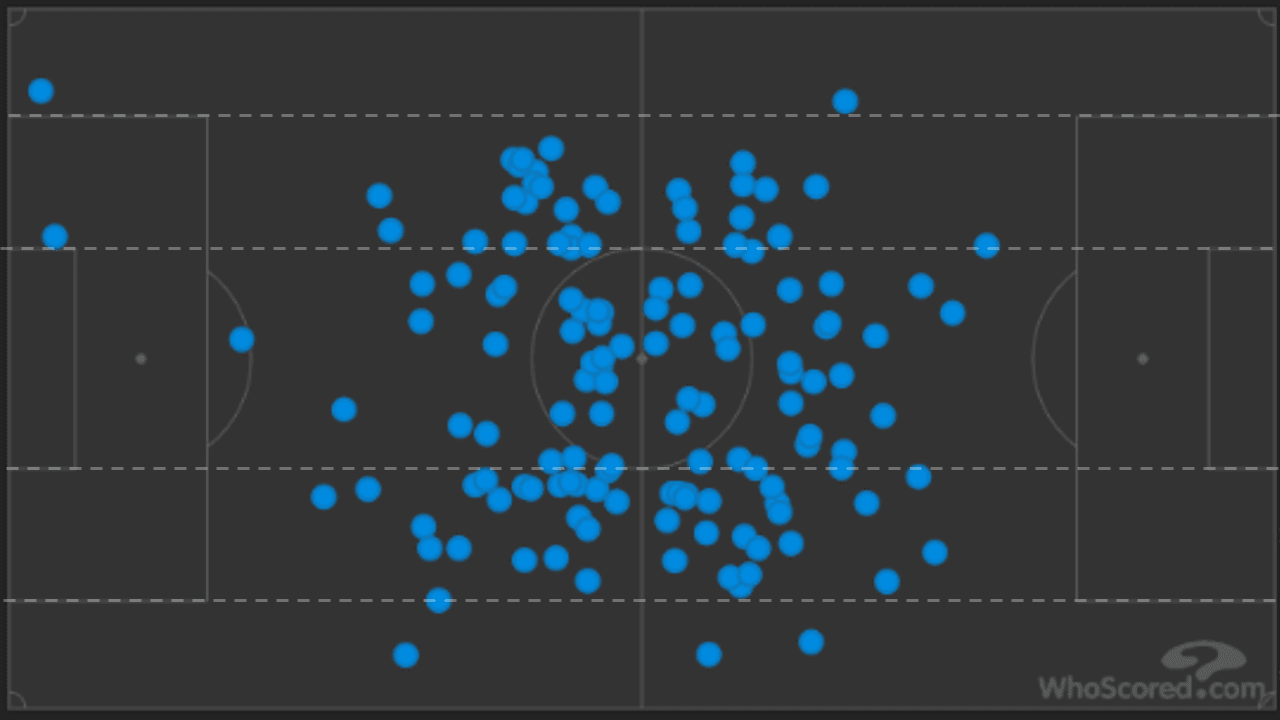
The defensive midfielder duo won 11 aerial duels together, along with Mendy and Cancelo winning two each. Despite Palace sitting in a low block and hitting on the counter, they were called offside three times during the game. This shows that nonetheless, Pep’s ‘makeshift’ defence, as the press labelled it, were quite efficient against Palace.
Gündoğan vacating the hole in buildup
In the Wolves game, Rodri playing in the hole was effectively neutralised by two forwards who marked him playing in the centre. In this game, Gündoğan always drifted to the sides into the inner corridors during buildup. This allowed either of the two centrebacks to push forward or cue an attacking player to drop deeper into the hole. This was very effective because Palace defended zonally in two rows of four. McArthur was the only player whose task was to mark the player between the lines in the left inner channel, which was usually De Bruyne during the first half.
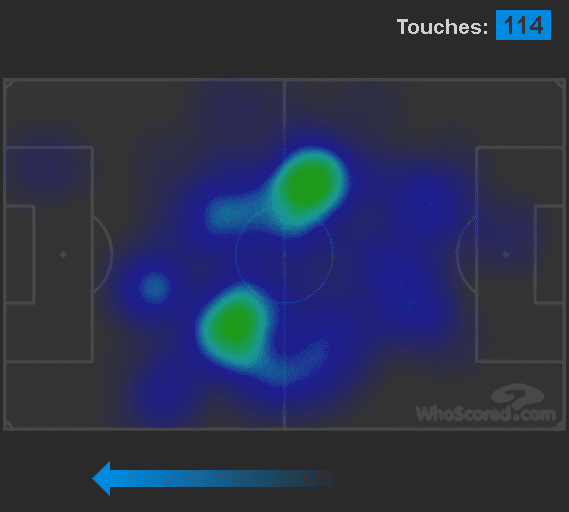
Playing zonally meant there was no pressure upon the City players advancing out from the back. In case one of the two Palace midfielders, Milivojević or Kouyaté would leave their position to press higher, the space would open up behind them in which City’s advanced players could receive the ball and progress.
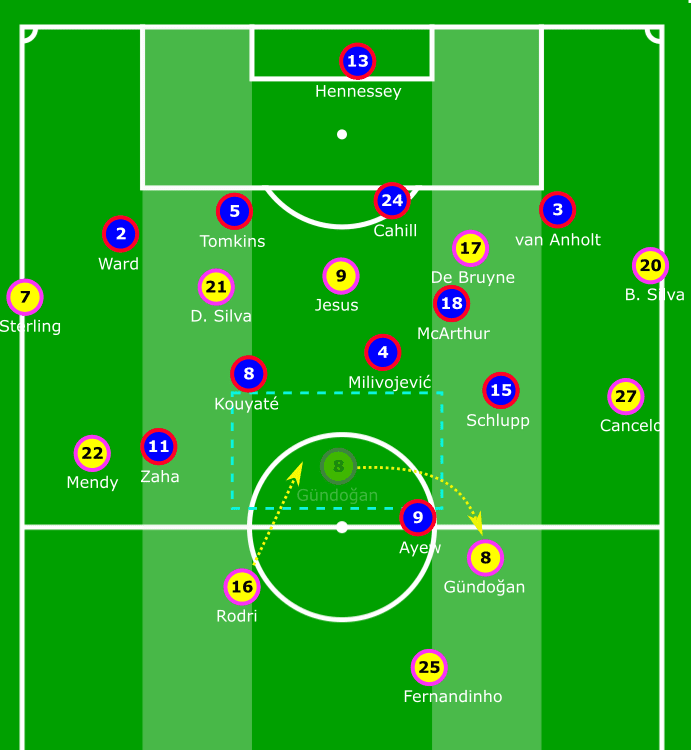
Gündoğan positioning in the half spaces rather than centrally also meant that he could have a better body orientation to receive and play forward than if he operated solely in the centre. We can see that he made 57 forward passes (52%) out of 108 passes which is quite a high ratio for a defensive midfielder.
City attacking organisation and goals
During the buildup, we saw Rodri, Fernandinho and Gündoğan having maximum number of touches on the ball as they progressed up the pitch with short passes. Mendy and Cancelo would often invert and position themselves in the inner corridors or half spaces at times in the same line as the midfielders while Sterling and Bernardo Silva operated on the wings. David Silva, Jesus and De Bryune were positioned between the two lines of Palace defence that defended zonally, but the three inside players would use plenty of movement to draw defenders out of their position.
De Bruyne having a free role on the right side was man-marked by McArthur, but he still managed to find space behind the defence to attack. This was because Bernardo’s wide positioning attracted van Aanholt pulling him wide and out of position. Centrally, David Silva and Jesus would pin the centre backs. Sterling positioned wide on the opposite flank would put a lot of pressure on Ward as he had to focus on two threats if there was an immediate switch of play.
We can see how this worked effectively in the graphic below. Bernardo comes short on the wide flank to receive the pass but he pulls van Aaanholt along with him. De Bruyne uses sharp turn and burst of pace to attack the space created by the right back moving out of position.
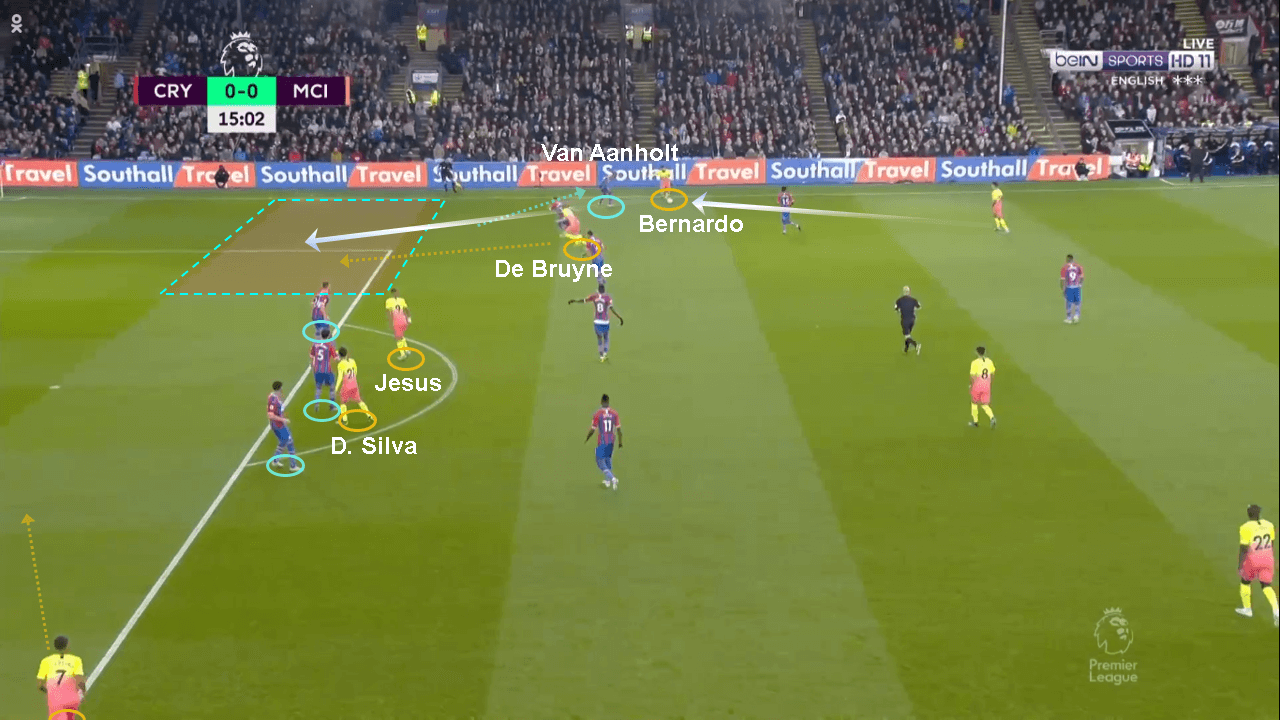
City scored two goals in quick succession giving no time for Palace to recover. The first goal was a result of intelligent movement from David Silva who comes short and then in front of Tomkins where Jesus was positioned. Jesus reads this movement and looks back to switch places with the Spaniard. As he checks back, he sees that Ward is paying attention to Sterling’s run off his blind side. Jesus takes advantage of this moment to move between the two defenders and find the back of the net with a header off a perfectly placed cross from Bernardo Silva.
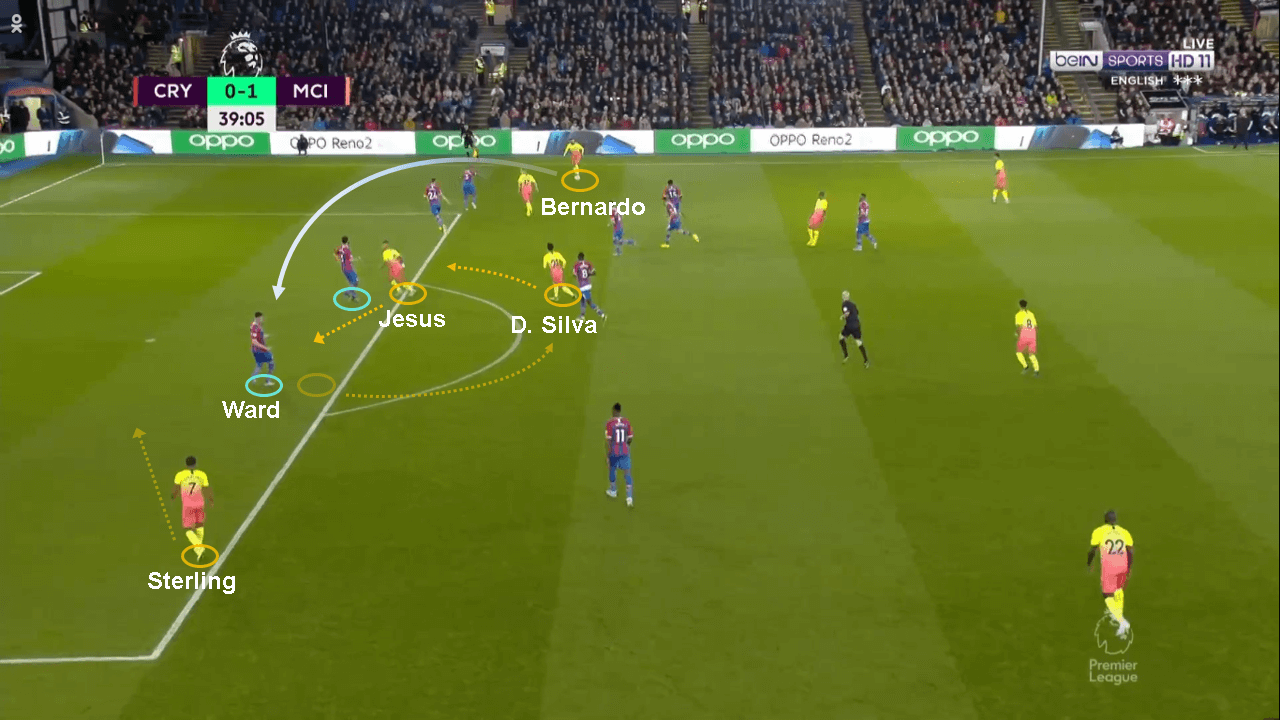
The second goal came immediately off the transition from the turnover after Palace’s restart. It was David Silva again who starts off playing a quick one-two with De Bryune in City’s half. He then sprints all the way again about 70 meters into the penalty box into the space behind the defenders and scores a fine volley from a chip by Sterling. His performance in this game came across as a positive reaction after Guardiola was unhappy with his work rate in the previous game.
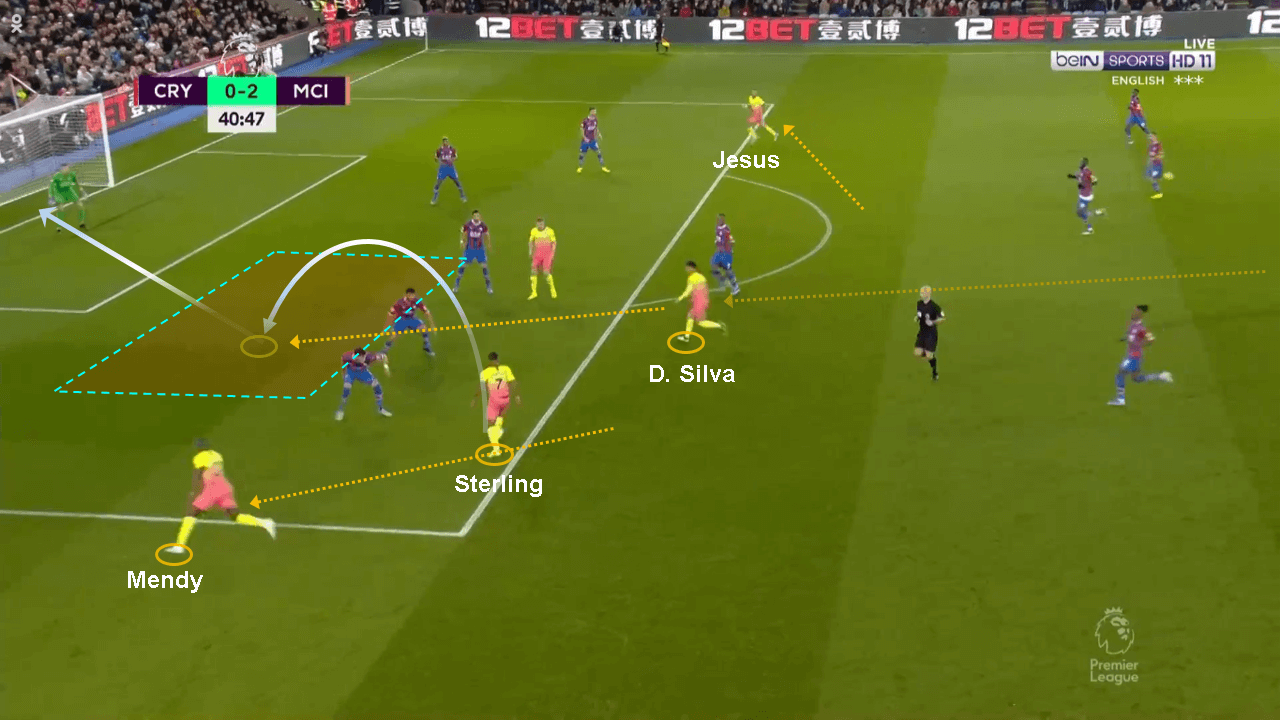
Palace’s counter-attacking strategy
Roy Hodgson intended to use Wilfried Zaha in the counter-attack for Palace for his technical dribbling ability, pace and physique that made him capable of holding the ball under pressure higher up the pitch. We saw him drift centrally from the wide position on the right and support Jordan Ayew.
The zonal defensive set-up was meant to cut passing lanes in City’s buildup and once possession was won, the strategy was to immediately play it wide for Ayew or Zaha. Since City committed so many players high up the pitch, they would leave plenty of vulnerable spaces behind them that Palace intended to exploit. Despite having a couple of quick breaks in this way, Palace weren’t able to create a lot of chances on the counter because of the defensive work shown by City’s attacking players. Here we see a situation where Rodri slips leaving Zaha free to attack the right flank, but Sterling tracks him all the way back and wins the ball at the edge of the penalty box with a great tackle.
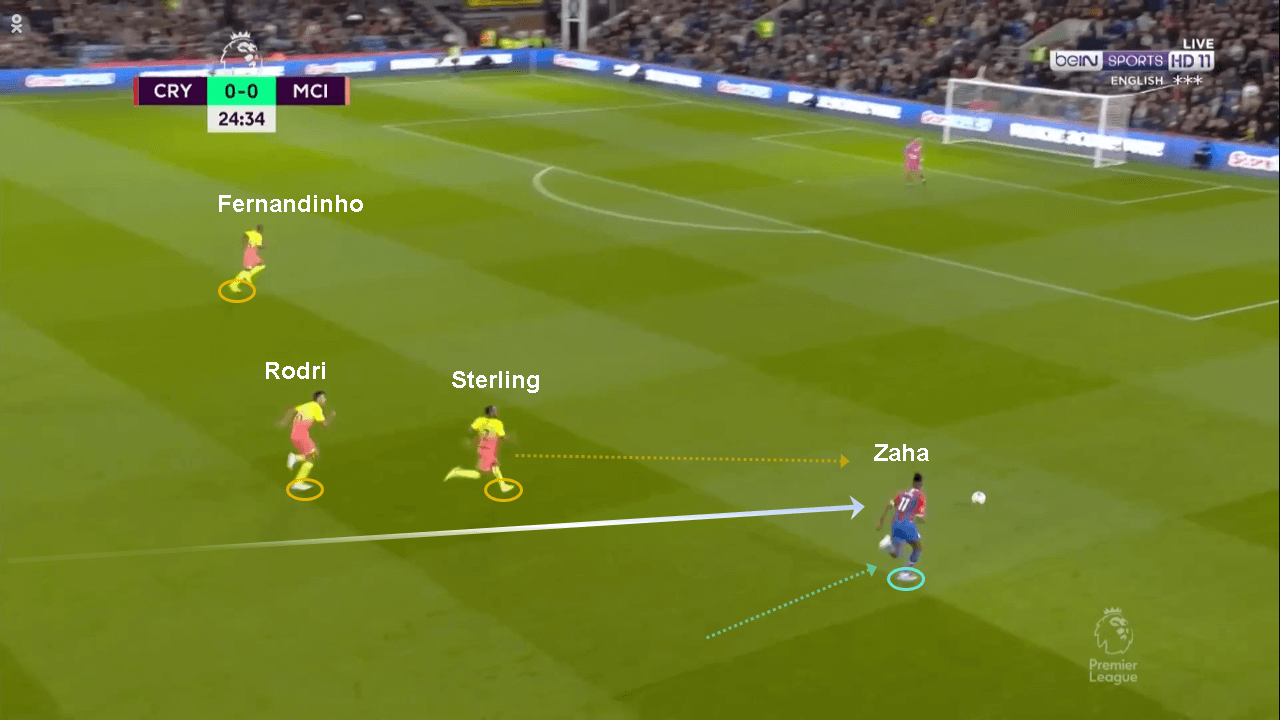
Palace were more effective in the attacking phase than on attacking transitions. They used quick one-touch passing to create opportunities to shoot on target past City’s defence. City’s defensive organisation was set up in a 4-4-2 mid-press with the objective of cutting the passing lanes to the fullbacks and Milivojević who played as the pivot.
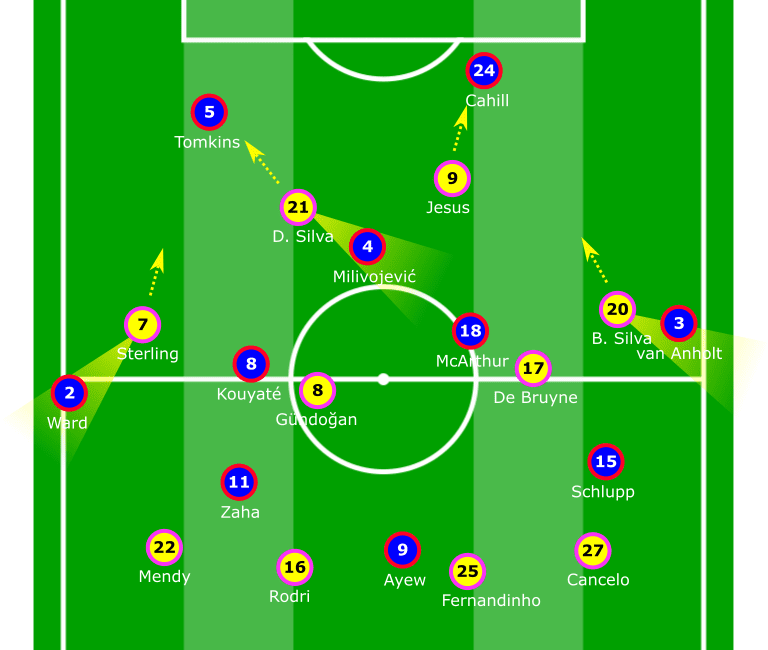
Both the keepers shined with some top drawers saves between the sticks. City only managed to score two goals falling short of their expected goals (xG) figure of 4.02 with Hennessey pulling off nine saves. Ederson also earned a well-deserved clean sheet denying Christian Benteke a header and Zaha a shot on goal which could have easily seen Palace equalise in the second half.
How did City’s positional play keep Palace at bay?
After conceding two goals just before half-time Palace came out and pressed city more aggressively in the second half. Their passes per defensive action (PPDA) dropped from 11.96 in the first half to 10.17 in the second half. Palace took more risks and managed to keep the ball more efficiently. Their possession rose from 25% to 31% in the second half. However City did not sit back and defend the lead, but continued to threaten them in search of another goal or two with intelligent positional play.
City’s objective throughout the game was to progress the ball creating superiorities behind opposition lines of pressure. The flat defensive structure by Palace helped. The City formation was very fluid and the players moved about constantly trying to receive the ball in pockets of space between defensive lines forcing the opposition back into their half. They also looked to switch the play from one side to the other which opened up spaces in Palace’s defence that they attacked.
A fine example was an instance when the ball was on the left side of the pitch in possession of Rodri. He finds Bernardo Silva who drifts in the centre all the way from the right as Gündoğan has vacated the hole for him to slot in. De Bruyne pushes deeper behind the lines drawing pinning back Ward and drawing Townsend with him. Now Sterling positions himself behind the midfield line of pressure centrally tucking in all the way from the left wing. But McArthur finds him and marks him between the lines. Hence the attack looks closed on the left. But Jesus, the centre forward drifts all the way wide to the right touchline.
Now, Cancelo picks the right moment to leave his fullback role and positions himself behind the midfield line in a new pocket of space in the right half-space. Bernardo finds him with a disguised pass and this opens a new passing lane to Jesus. Cancelo stays in his new position in the half-space to be part of the attack now from the right, he is able to become a wall-passer for Jesus who cuts inside and registers a shot on goal which was remarkably saved by Hennessey.
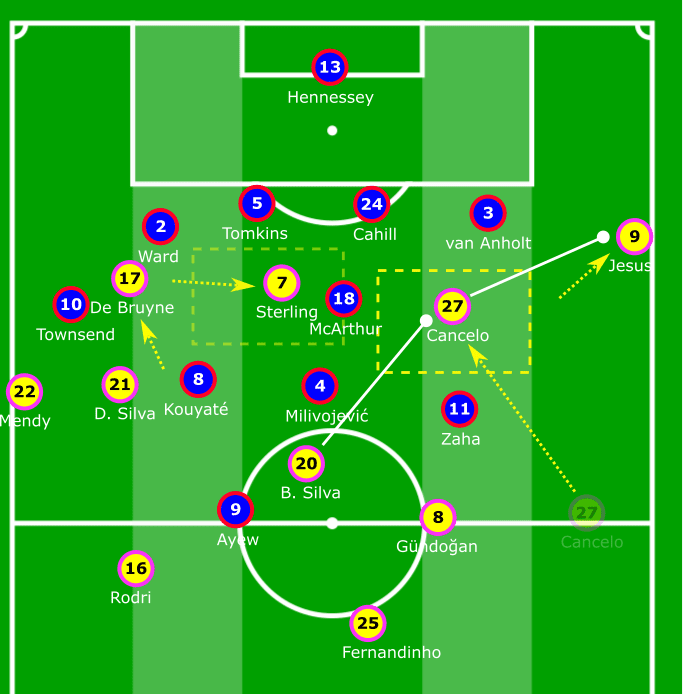
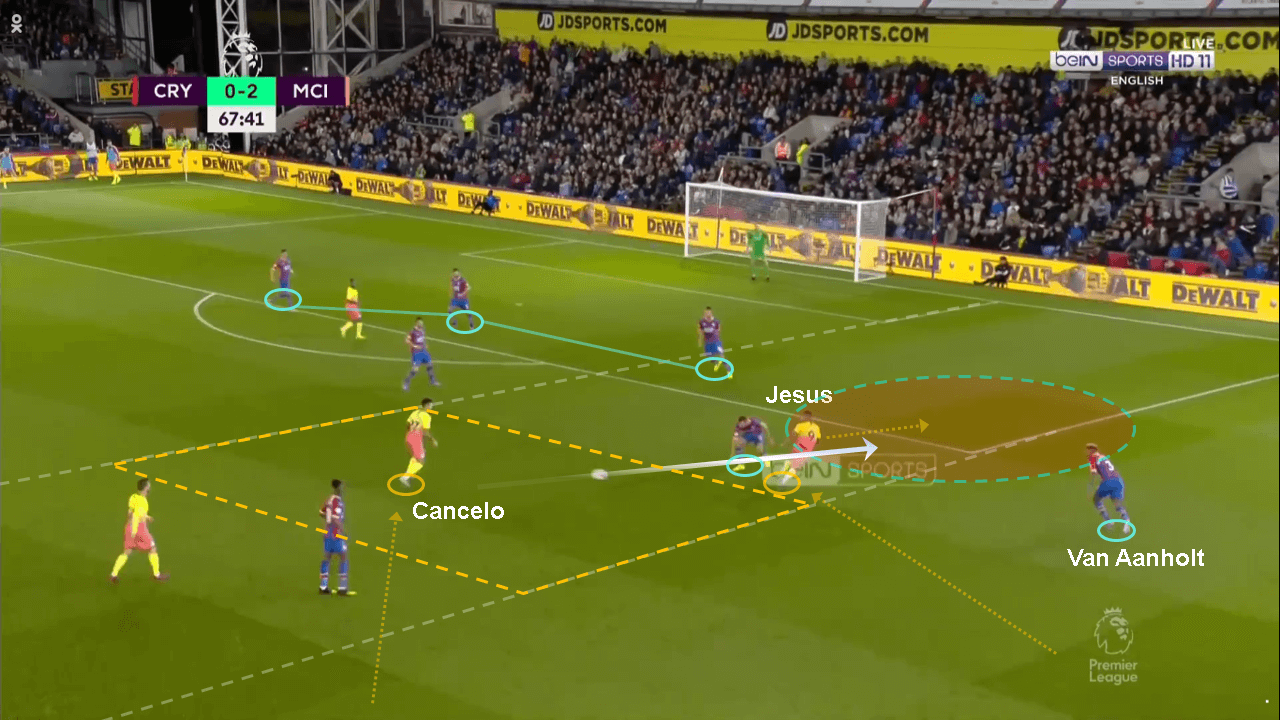
These intelligent positional movements made it impossible for Palace to mark them defensively and City continued to constantly threaten Palace’s goal. Jesus’s movement to drift wide, De Bruyne, Sterling and Bernardo attacking the channels inside made the attacks very positional and dynamic. Jesus being the central striker registered six dribbles, the most number of dribbles for City followed by Sterling with four dribbles. At many times it appeared as if City operated without a permanent striker, reminiscent of Pep’s Barca days when he quoted,
‘My striker is the free space in front of the opposition defence.’
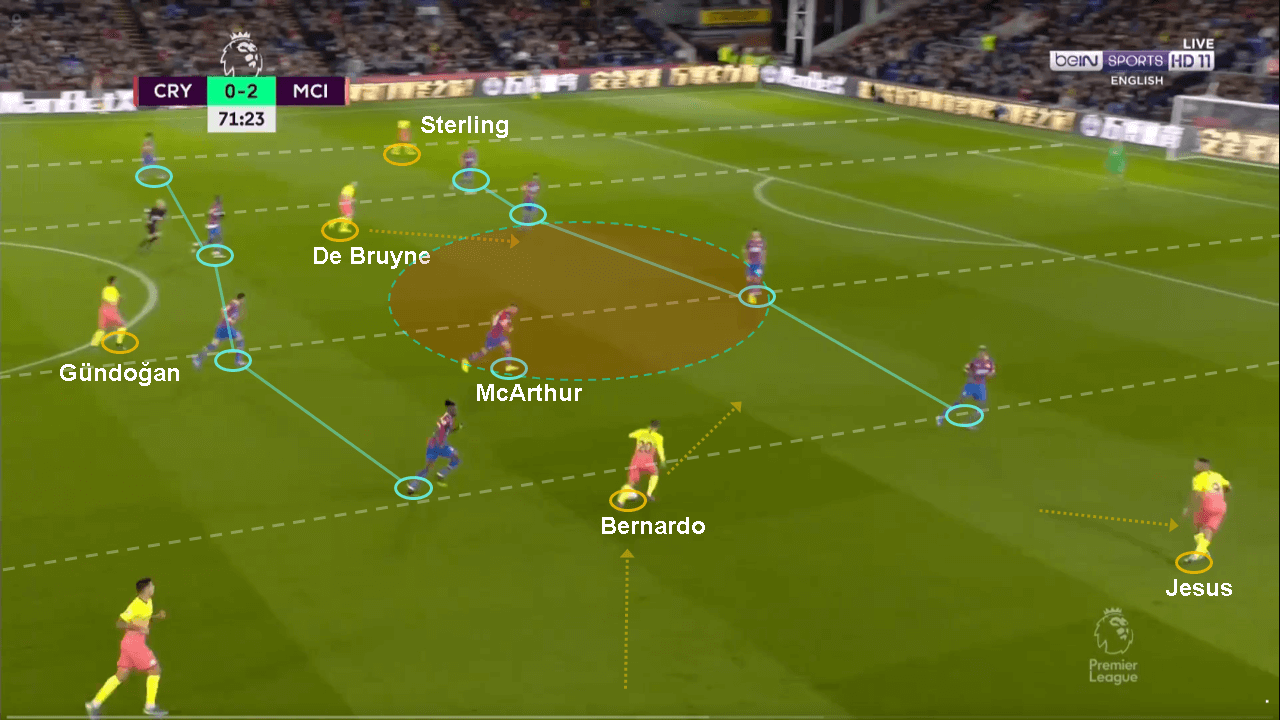
Conclusion
Guardiola would have planned to kill the game early by converting the chances created from an extremely attacking game so that City would have a sufficient margin of lead to rest some of their key players for the Champions League fixture on Tuesday. But Crystal Place fought relentlessly keeping the game open especially in the final minutes at Selhurst Park. John Stones, making an appearance after his injury, only managed 14 minutes but Pep would have certainly wished for him to have more if he intends to use him against Atalanta on Tuesday.
When defeats such as the one he faced at home against Wolves invite scepticism about his tactics, Guardiola always manages to respond by sticking to his playing principles more fervently in the following game. Although there are a lot of players such as Rodri and Cancelo who are still adapting to Pep’s school of positional play, this game was perhaps the closest to Guardiola’s dominant game model since the start of this season. Three points are just what they needed after the setback before the international break, and with Liverpool having drawn to Manchester United over the weekend, the gap now closes down to six points.
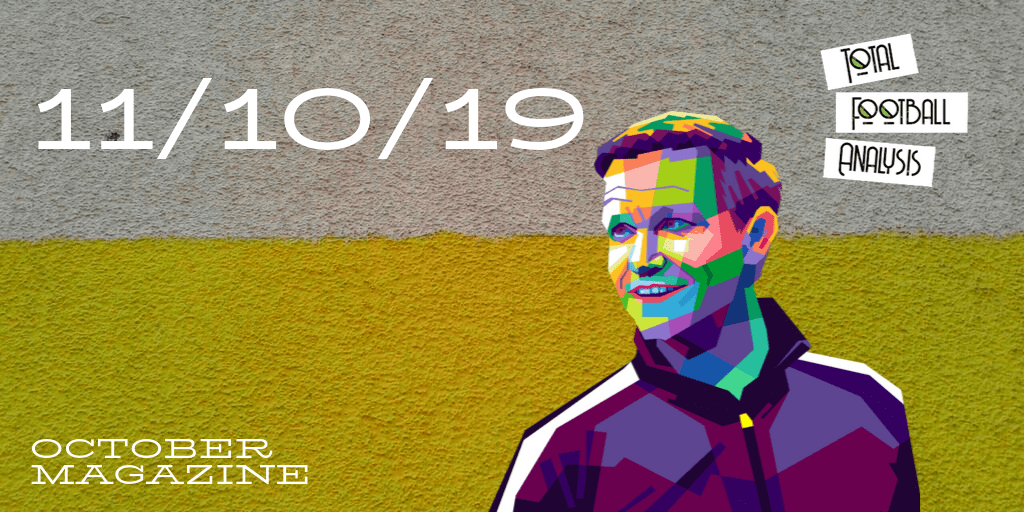
If you love tactical analysis, then you’ll love the digital magazines from totalfootballanalysis.com – a guaranteed 100+ pages of pure tactical analysis covering topics from the Premier League, Serie A, La Liga, Bundesliga and many, many more. Buy your copy of the October issue for just ₤4.99 here





Comments